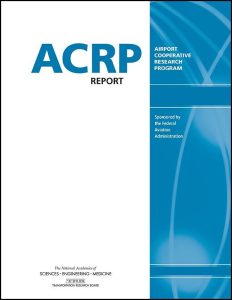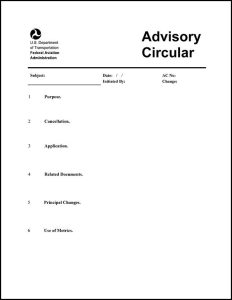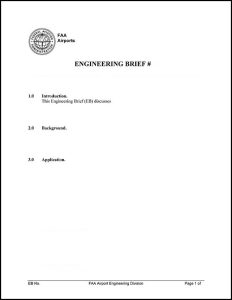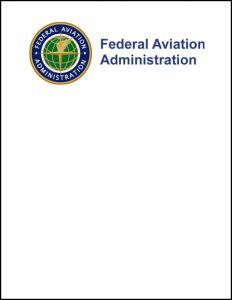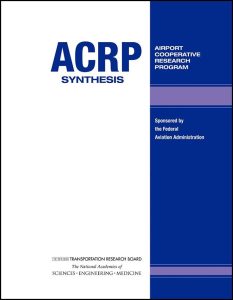To narrow the library of airside resources, use the filter boxes or airport map below or search box above.
Click an item below to expand.
Resources Matching Your Search
2010
ACRP Report 38 provides a comprehensive description of the regulations, standards, evaluation criteria, and processes designed to protect the airspace surrounding airports. Aviation practitioners, local planning and zoning agencies, and developers need to understand and apply the appropriate airspace design and evaluation criteria to ensure a safe operating environment for aircraft as well as to maintain airport operational flexibility and reliability, without unduly restricting desirable building development and attendant economic growth in the surrounding community.
2019
ACRP Research Report 195 is designed to assist airport operators in developing and implementing an obstruction management program to protect the airport airspace from encroachment by tall objects. The report will help airport staff develop an obstruction management plan by understanding the regulatory environment, identifying obstructions, and developing a strategy for communication with surrounding communities that will ensure airport involvement in any development issues that could result in an obstruction around the airport. The report is supplemented by ACRP WebResource 7: Best Practices for Airport Obstruction Management Library, which provides reference documents, model documents, and presentation materials for obstruction management outreach. A methodology for creating a composite map of all applicable airspace surfaces as well as examples of interactive airspace composite surface maps for small and large airports are also provided.
2021
This resource is a webpage that provides information on the Electronic Code of Federal Regulations (e-CFR) Title 14, Chapter I, Subchapter G, Part 139, which contains guidance on certification, airport certification manual, and operations.
2021
This resource is a webpage that provides information on the Electronic Code of Federal Regulations (e-CFR) Title 14, Chapter I, Subchapter E, Part 77, which contains guidance on the safe and efficient use as well as the preservation of the navigable airspace.
1983
This advisory circular (AC) provides guidance for noise control and compatibility planning for airports under Federal Aviation Regulation (FAR) Part 150 and the Aviation Safety and Noise Abatement Act of 1979 (ASNA) (P.L. 96-193). It is intended for use by airport operators, state and local planners and other officials, and interested citizens who may engage in noise control planning.
2013
Engineering Brief (EB) 91 provides new information and requirements for the management of vegetation on and/or surrounding an airport. This EB provides information on the removal or topping of vegetation as well as the collection, submission, and management of the supporting data regarding vegetation.
2012
This FAA memorandum presents interim policy guidance on compatible land uses within runway protection zones (RPZ) to address recurrent questions about what constitutes a compatible land use and how to evaluate proposed land uses that would reside in an RPZ.
2021
This resource provides a line of communication from airport sponsors to the FAA with development on or around the airport. In administering Title 14 of the Code of Federal Regulations (14 CFR) Part 77, the prime objectives of the FAA are to promote air safety and the efficient use of the navigable airspace. To accomplish this mission, aeronautical studies are conducted based on information provided by proponents on an FAA Form 7460-1, Notice of Proposed Construction or Alteration. Registration and a login is required to access the website and is available to any user who registers.
2018
ACRP Research Report 184 is the executive summary of ACRP Web-Only Document 44: Understanding FAA Grant Assurance Obligations, Volume 1: Guidebook, and explains each of the 39 grant assurances. The summary includes a matrix that outlines major aspects of the program such as duration and applicability, and provides a list of related assurances. The matrix includes links to specific volumes of the web-only document that discuss each grant assurance in greater detail. Volume 2: Technical Appendices contains supplemental information, Volume 3: Research Report discusses the research effort, and Volume 4: Summary of AIP Grant Assurance Requirements includes a PowerPoint presentation for sharing content with airport manager, planners, and operators.
2015
ACRP Synthesis 61 reviews current practices in developing and preserving public-use seaplane bases throughout the United States. The report reviews and presents information on the planning process, design considerations, permits, regulatory requirements, and facility and service needs of seaplane bases.
2018
ACRP Web-Only Document 44, Volume 1, provides a comprehensive summary of all the requirements included in the 39 Grant Assurances applicable to airport sponsors, who are owners or operators of the airport that execute the grant agreements. The web-only document describes the requirements, identifies the actions that are required and those that are prohibited, identifies exceptions, describes the duration and applicability of the requirements, and discusses the potential consequences of non-compliance.
2018
ACRP Web-Only Document 44 provides supplemental information for individuals desiring a more in-depth understanding of the requirements. It may be useful when airport management, staff, or airport users are confronted with a particular issue or a set of circumstances that is not fully addressed in ACRP Research Report 184. The web-only document contains six appendices providing supplemental information on the Grant Assurance requirements, as well as resources and references.
2018
ACRP Web-Only Document 44, Volume 3, summarizes the research efforts and results of the research conducted to develop a guidebook on FAA grant assurance requirements.
2018
ACRP Web-Only Document 44, Volume 4, is a model PowerPoint presentation for sharing content with airport managers, planners, and operators.
2020
This desk reference provides explanatory guidance for environmental impact analysis performed to comply with Council on Environmental Quality (CEQ) Regulations for Implementing the Procedural Provisions of the National Environmental Policy Act (CEQ Regulations) (40 Code of Federal Regulations (CFR) parts 1500-1508); U.S. Department of Transportation (DOT) Order 5610.1C, Procedures for Considering Environmental Impacts; and Federal Aviation Administration (FAA) Order 1050.1F Environmental Impacts: Policies and Procedures.
2019
This advisory circular (AC) contains the FAA specification for obstruction lighting equipment used to increase conspicuity of structures to facilitate early obstruction recognition by pilots.
2012
This advisory circular (AC) provides standards for the design of heliports serving helicopters with single rotors. Basic concepts to facilities serving helicopters with tandem (front and rear) or dual (side-by-side) rotors apply; however, many standards will not apply.
2013
ACRP Report 86 explores a protocol for evaluating and optimizing aircraft departure procedures in terms of noise exposure, emissions, and fuel burn. An accompanying CD-ROM contains a spreadsheet-based Departure Optimization Investigation Tool (DOIT) that allows users to understand and test tradeoffs among various impact measures, including noise levels, rate of fuel consumption, and emissions.
2016
ACRP Research Report 168 helps airport operators evaluate the risk of an aircraft accident within a runway protection zone (RPZ). Although RPZs are supposed to be clear of structures and people, it is still common for activities to occur within an RPZ for many reasons, and these reasons can be beyond the control of the airport operator. The report is accompanied by a tool used to assess the risk of an aircraft accident within the RPZ and, based on that output, assess the risk to people and property, considering population density and land use. The tool can be used to run scenarios for planning around an RPZ or if changes are being considered, such as a change in the threshold, extending a runway, removing a hazard, and planning for a new runway.
2015
This advisory circular (AC) provides guidance for the preparation of master plans for airports that range in size and function, from small general aviation to large commercial service facilities. The intent of this AC is to foster a flexible approach to master planning that directs attention and resources to critical issues. The scope of each master plan must be tailored to the individual airport under evaluation.
